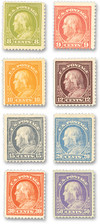
# 414-21 - 1912 Franklin, single line watermark, set of 8 stamps
Are You Missing These 1912-14 Washington-Franklin Stamps?
Single Line Watermark, Perforated 12
The Washington-Franklins are among the most fascinating and challenging US stamps to collect. Issued between 1908 and 1922, they encompassed over 200 varieties, five different designs, two paper types, three printing methods, at least 14 perforations, several colors, and 20 denominations.
You can come one step closer to completing your Washington-Franklin collection with this convenient set of eight stamps. Each of these stamps was printed on single line watermark paper and perforated 12. They were the result of a change in the Washington-Franklin Series meant to aid postal workers…
Franklin Featured on Higher Denominations
To avoid confusion among postal clerks, officials decided to picture George Washington on all Series of 1912-14 denominations of 7¢ or lower. Denominations of 8¢ and above pictured Benjamin Franklin.
When the Post Office Department first issued the 1908 series, there were not enough different color inks for each denomination. Therefore, various shades of each color were used. For example, the 1¢ and 8¢ were both printed in green, and the 3¢ and 50¢ in purple, and the 5¢ and 15¢ in blue. Postal clerks complained that the stamps were too similar, making them difficult to distinguish, especially if they were in a hurry. In addition, the poor artificial lights hindered their ability to differentiate between the subtle shades.
Experiments were conducted using different inks printed on colored paper. These tests, however, determined this was not an effective solution to the problem. Finally, it was decided that the series should simply be split in half. The first seven stamps in the series (1¢ – 7¢) carried the portrait of the Father of our Country, while the remaining stamps (8¢ – $1) pictured our first postmaster general.
The stamps bearing Benjamin Franklin’s picture were given a new border design, which like the previous one, was simple, yet artistic. The stamps were printed on single line watermarked paper, except for the 50¢ and $1 denominations. When the change was made to the single line watermark, the Bureau still had a small supply of double line watermarked paper on hand. Since the demand for these stamps was small, they decided to use the leftover paper to print the high-value denominations.
Are You Missing These 1912-14 Washington-Franklin Stamps?
Single Line Watermark, Perforated 12
The Washington-Franklins are among the most fascinating and challenging US stamps to collect. Issued between 1908 and 1922, they encompassed over 200 varieties, five different designs, two paper types, three printing methods, at least 14 perforations, several colors, and 20 denominations.
You can come one step closer to completing your Washington-Franklin collection with this convenient set of eight stamps. Each of these stamps was printed on single line watermark paper and perforated 12. They were the result of a change in the Washington-Franklin Series meant to aid postal workers…
Franklin Featured on Higher Denominations
To avoid confusion among postal clerks, officials decided to picture George Washington on all Series of 1912-14 denominations of 7¢ or lower. Denominations of 8¢ and above pictured Benjamin Franklin.
When the Post Office Department first issued the 1908 series, there were not enough different color inks for each denomination. Therefore, various shades of each color were used. For example, the 1¢ and 8¢ were both printed in green, and the 3¢ and 50¢ in purple, and the 5¢ and 15¢ in blue. Postal clerks complained that the stamps were too similar, making them difficult to distinguish, especially if they were in a hurry. In addition, the poor artificial lights hindered their ability to differentiate between the subtle shades.
Experiments were conducted using different inks printed on colored paper. These tests, however, determined this was not an effective solution to the problem. Finally, it was decided that the series should simply be split in half. The first seven stamps in the series (1¢ – 7¢) carried the portrait of the Father of our Country, while the remaining stamps (8¢ – $1) pictured our first postmaster general.
The stamps bearing Benjamin Franklin’s picture were given a new border design, which like the previous one, was simple, yet artistic. The stamps were printed on single line watermarked paper, except for the 50¢ and $1 denominations. When the change was made to the single line watermark, the Bureau still had a small supply of double line watermarked paper on hand. Since the demand for these stamps was small, they decided to use the leftover paper to print the high-value denominations.













